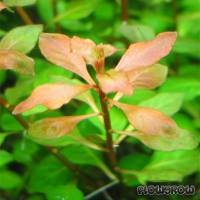



Ludwigia palustris is a plant distributed in virtually all the world in boggy habitats. It is not a native plant to Australasia, however, it was introduced into that region. It is even found in Germany, but only in very few places, and according to the Red List Germany of 1996 it is considered a critically endangered species.
L. palustris is an extremely variable species and can be found in shallow ponds and other stagnant to slow-flowing waters, submersed and emersed. Then it grows in a creeping habit. It has been used in the hobby for many years, sometimes known as "Red Ludwigia" or "L. mullertii", a trade name also used for L. repens and L. palustris x repens. However, often even those plants sold as "Red Ludwigia" and as true L. palustris are in reality L. palustris x repens.
A bright green variety of Ludwigia palustris is sold by the company Dennerle.
First and foremost, Ludwigia palustris needs lots of light. Even though it may survive under moderate light, it grows spindly and greenish.
It responds well to the addition of the macronutrients NO3 and PO4, however, they are not necessarily required. CO2 injection and micronutrient fertilisation are both not necessary either, however, Ludwigia palustris grows considerably more robust, healthy and colourful if they are added.
Unlike so many other plants from temperate climates, Ludwigia palustris is very adaptable to different temperatures and also does well in warmer water. Lots of light and a substrate rich in nutrients induce an almost horizontal growth habit in this species, and further the formation of roots and a great number of lateral shoots.
When cultivated outdoors, be it emersed on the edges of garden ponds or in containers, L. palustris develops flowers with four green calyx tips and four yellow stamina but no petals. These petal-less flowers are one characteristic L. palustris can be identified on quite easily; L. repens, which looks very similar to L. palustris, has four small petals. However, the hybrid L. palustris x repens may form flowers that look exactly like those of L. palustris, so this is not an unequivocal feature. Sometimes, in comparison with L. repends and L. palustris x repens, L. palustris has longer leaf stalks. Plants with reddish leaf rims, stems and leaf midribs are in the absolute majority of cases L. palustris, even though similar characteristics may surface in some varietys of L. repens, too.
This plant is propagated like all stem plants: cut off lateral or top shoots and re-plant in the substrate. After removal of the top shoot, the remaining stem produces a great number of lateral shoots when left in the aquarium.
This species has many colour varietys. Especially the reddish form is a very decorative aquarium plant and can be used as an eyecatcher in the middleground of the tank. It is most stunning if plants with fine-structured foliage and light to dark green colours form its backdrop.
<a href="https://www.flowgrow.de/db/aquaticplants/ludwigia-palustris" target="_blank"><img alt="Ludwigia palustris" title="Ludwigia palustris" src="https://www.flowgrow.de/db/widget/aquaticplants/ludwigia-palustris" /></a>
[url=https://www.flowgrow.de/db/aquaticplants/ludwigia-palustris][img]https://www.flowgrow.de/db/widget/aquaticplants/ludwigia-palustris[/img][/url]
[widget=aquaticplants/ludwigia-palustris]Ludwigia palustris[/widget]